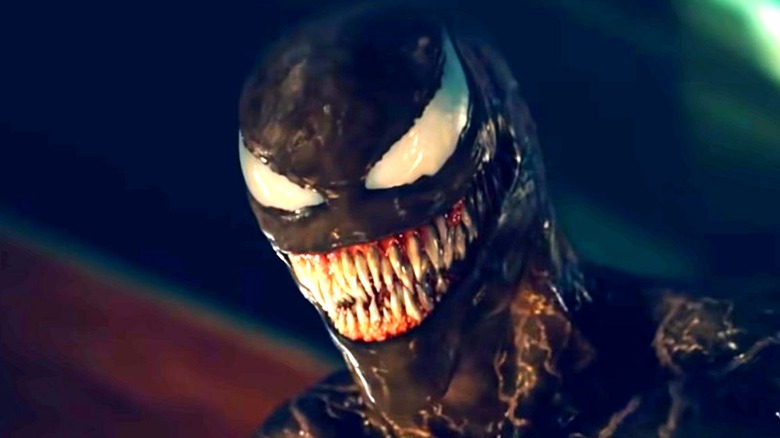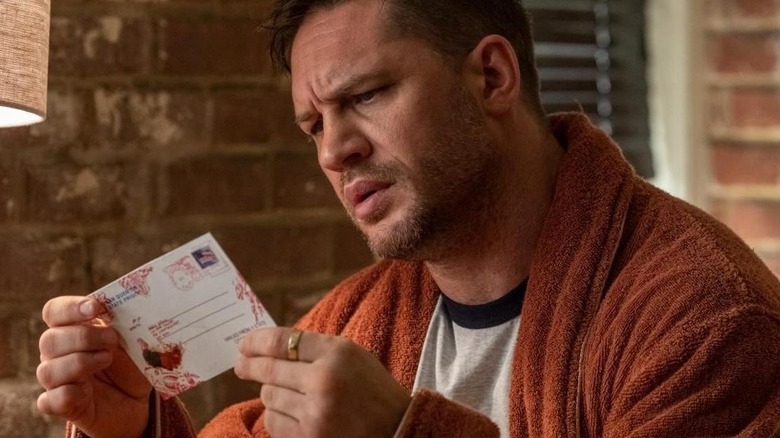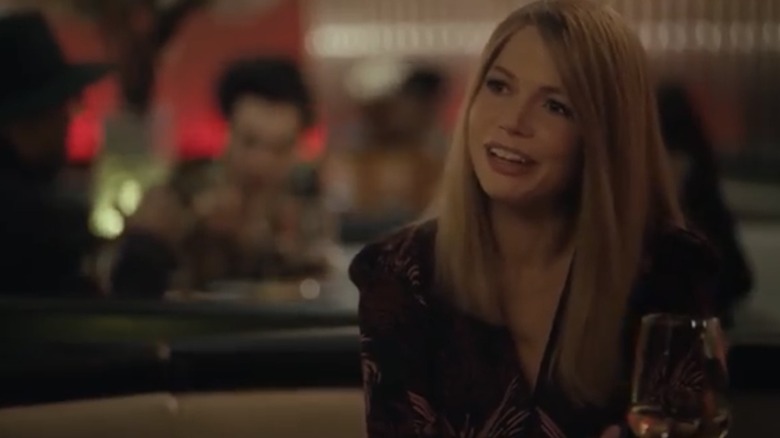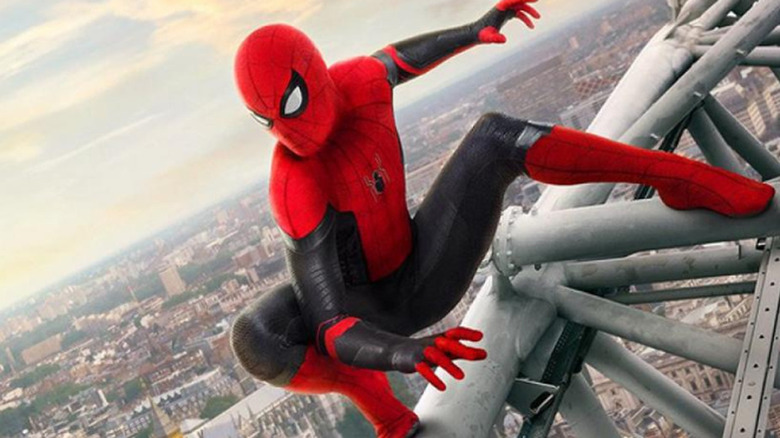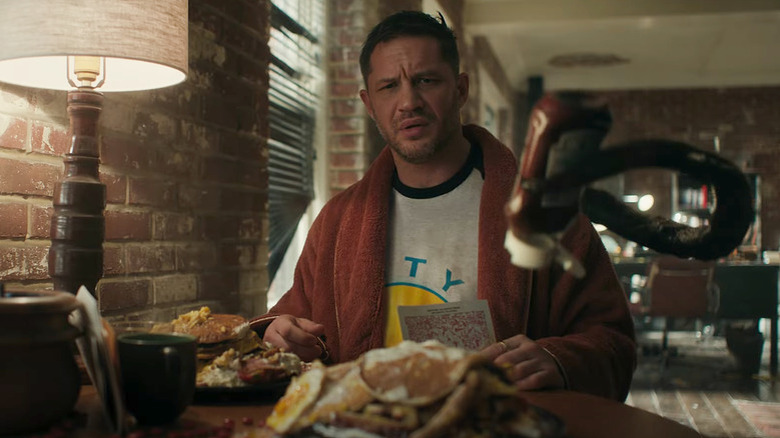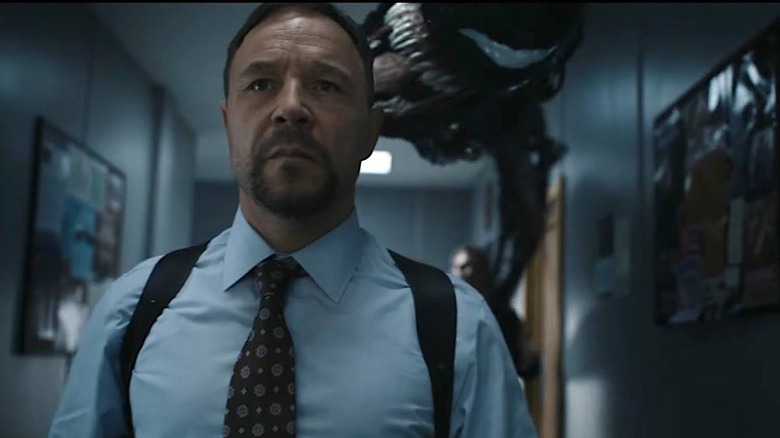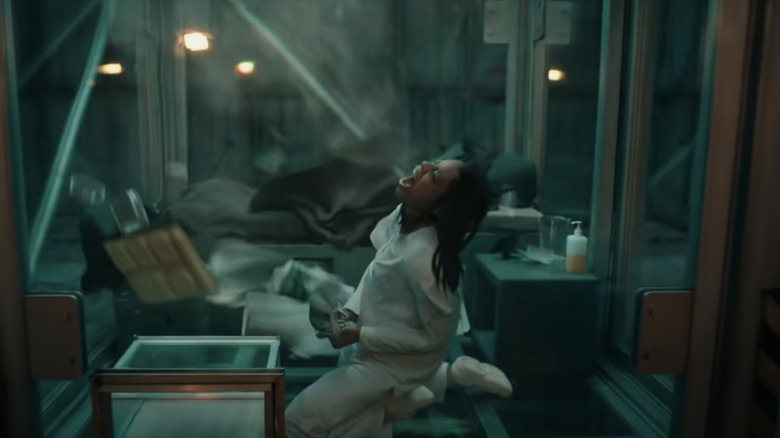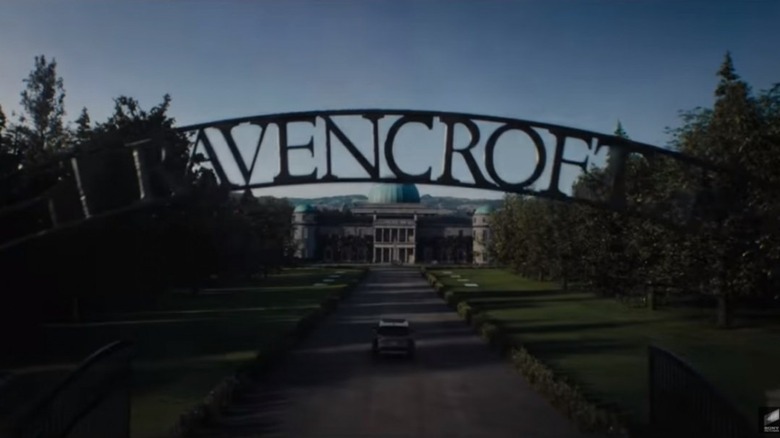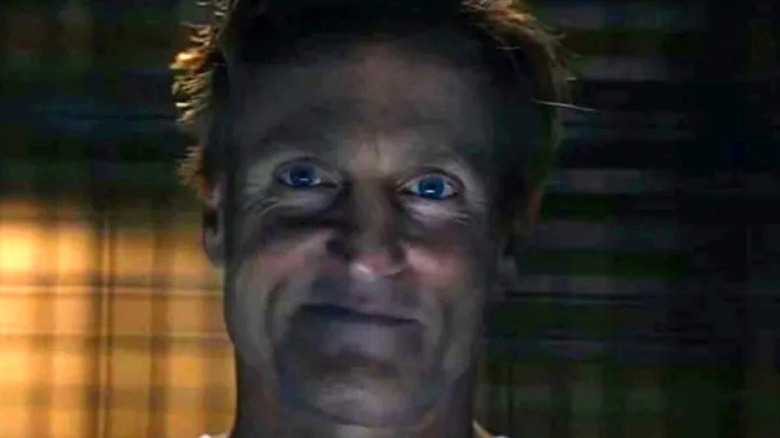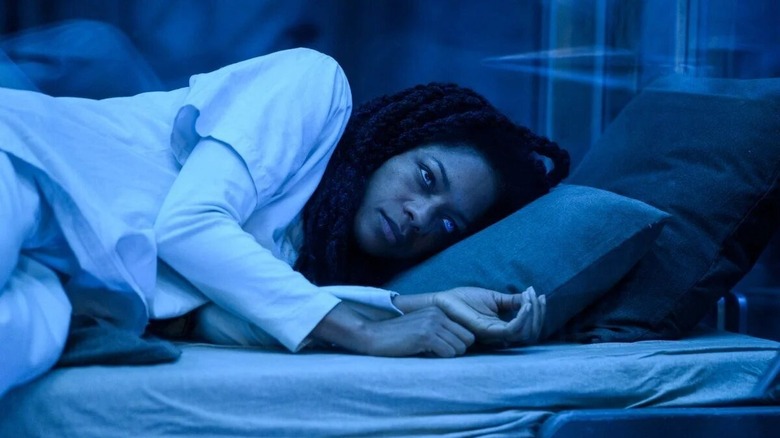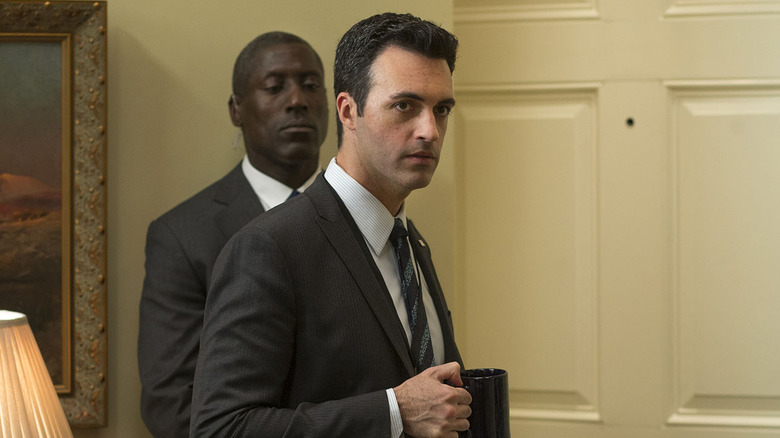Unanswered Questions We Have After Watching Venom: Let There Be Carnage
Within its first 10 minutes, "Venom: Let There Be Carnage" channels Hammer Films, "The Silence of the Lambs," and Jim Carrey's "Liar Liar." One of these things is not like other. Specifically: One is the closest Jim Carrey ever came to comically emulating Jimmy Stewart and Dean Martin simultaneously. And that is — deep breath — what Tom Hardy is up to as Venom, as well. Sort of, anyway.
Is that take ridiculous? Yes, but so is "Venom: Let There Be Carnage." Andy Serkis' third film as feature-length director shoves Gothic horror, Thomas Harris, and slapstick comedy into a cinematic blender and lets the contents splatter over audiences worldwide. The mixture includes a truly righteous PG-13 f-bomb, a set piece that recalls the best of "The Crow" and the worst of 2003's "Daredevil," and Woody Harrelson recounting trauma against footage of animated murders, all drawn in a bad-boy Calvin shorthand.
But while 2018's "Venom" left viewers with little to think about, "Venom: Let There Be Carnage" offers a carnival of strangeness — much of it driven by corporate synergy — to ponder. Like its performers, "Venom: Let There Be Carnage" really and truly goes for it. Here are 10 questions we have following "Venom: Let There Be Carnage." Just beware: Major spoilers, including for the film's already-famous credits scene, follow.
What brought Venom to the MCU?
The post-credits scene of "Venom: Let There Be Carnage" is only about 90 seconds long, but it yields the moment that Tom Hardy's cryptic Instagram posts and the "Mobius" trailer hinted at: Venom is in the Marvel Cinematic Universe.
Here's what happens: While watching TV, Venom and Eddie are moved to a slightly different version of the beachside bungalow where they're laying low. Suddenly, J. Jonah Jameson (J.K. Simmons, reprising his role from both "Spider-Man: Far from Home" and the Raimi films) is on the television, revealing that Peter Parker (Tom Holland) is Spider-Man, just like he did in "Far from Home." Eddie looks confused. Venom licks the screen. The internet goes wild.
The sequence is terrific fan service, but it also begs the question of how Eddie and Venom joined the MCU. The assumed answer is Dr. Stephen Strange, who is seen messing with the multiverse in the "Spider Man: No Way Home" trailer. And the flash that Eddie and Venom encounter, however brief, happens to be the Doctor's favorite spell-casting shade: gold. However, we also know that the multiverse-shifting events of "Spider Man: No Way Home" occur sometime after Jameson reveals Peter Parker's identity. So, does Venom's arrival precede the good Doctor's machinations? If yes, then who brought him there? It's a moment that yields more questions than answers, including our next one...
Did anything else from Venom: Let There Be Carnage make the jump to the MCU?
"Venom: Let There Be Carnage" is much better than its predecessor when it comes to character development. Ok, maybe "development" is overstating things, but the latest Venom movie makes room for Dr. Dan Lewis' heroic actions, a Mrs. Chen subplot, and a scene in which Michelle Williams does some movie star-worthy flirting with a gooey parasite. All of this makes the cast of "Venom: Let There Be Carnage" worth spending more time with. And given that the movie hints at a continuity-furthering sequel, one would expect these characters to appear again, right?
Well, there's the rub. It's not at all clear if anyone else from the "Venom: Let There Be Carnage" timeline has been flashed into the MCU. Beyond that, it's hard to fathom how they could factor in already-crowded cast of "Spider-Man: No Way Home," or any of the other upcoming Marvel flicks. A little Venom already goes a long way — is there room for his supporting cast in the MCU, too? We'll have to wait and see.
When will Venom appear in an MCU movie?
If you've read this far, you've probably seen "Venom: Let There Be Carnage" (or have a significant appetite for spoilers), and you've probably wondered if Venom's first MCU appearance will be in the forthcoming "Spider Man: No Way Home." After all, set reports suggesting a Sinister Six reveal have been trending on social media for months, and Eddie Brock has been a member of that group before. However, as discussed, it's not entirely clear when Venom joined the MCU, which begs the question: What will Venom's first MCU movie be?
In addition, we don't know if Venom will first pop up in an MCU movie, or if traffic is going to move the other way. Although it seems unlikely, there's no reason why Spider-Man couldn't show up in a Venom film, and not the other way around. Making Venom the focal point, not Spidey, would be the easiest way to get out of the shadow of "Spider-Man 3," a film that notoriously mishandled Venom in the eyes of many fans and critics. It would also avoid the tonal clash that the Marvel films might have some difficulty navigating.
How will Venom's comedic tone mesh with the MCU's?
There's a Twitter review of "Venom: Let There Be Carnage" from user RyansCardssLLC that I've been thinking about since I saw the film: "Action scenes were tough, comedy was enough."
"Comedy was enough." This is the Rosetta Stone that explains the Venom films' mind-boggling success. Ruben Fleischer and Andy Serkis' films are full of laugh-out-loud moments. Venom attending a rave. Venom calling Eddie Brock an unprintable word after he refuses to jump off a building. "Let's there Be Carnage" in particular cultivates a gloriously dumb comedic streak that combines slapstick and jokes about using bad guys' heads as bowling balls. It truly is enough.
Will the MCU make room for the "Venom" movies' singular sense of humor? While there are certainly silly and odd moments in Marvel's movies (the Guardians of the Galaxy films in particular), they are hardly as bizarre as what Tom Hardy has been up to for the last three years. The action scenes of "Venom" are tough; its comedy isn't. Kevin Feige has some decisions to make.
What happened to Detective Mulligan?
Venom's post-credits sequence is so game-changing that it has eclipsed the rest of the movie, which is full of equally weird highlights. Those include a Little Simz concert, Michelle Willams flirting with a possessed Mrs. Chen, and the late-breaking reveal that Detective Mulligan, the officer who blinded Shriek, is possessed with — well, something.
During the film's final, church-set sequence, Shriek attempts to take revenge on the police officer, but doesn't succeed. As Eddie and Venom flee the scene "Dark Knight"-style, the camera pans up to catch the injured Mulligan, eyes glowing white and red, whispering, "Monsters, monsters everywhere." What's happening here?
Turn to Marvel's comic books for clues. 2004's "Venom vs. Carnage" #2 introduces Toxin, a symbiote that Cletus Kassidy reluctantly gives birth to (this is not a typo) and swears to kill. He goes so far as to bond it to Mulligan, a cop he already loathes. Venom, however, intervenes, saving his grandchild before Kassidy can slaughter him. Toxin then goes on and tries his gooey hands at the whole superhero thing.
Casting an actor of Graham's ability as Mulligan implies that Toxin might have a future in the Venom films, and given that Andy Serkis has admitted that the "Let There Be Carnage" post-credits scene almost didn't happen, one wonders what the original plan for Mulligan really was — and what it is now.
Does Shriek's presence hint that we're getting mutants in the MCU?
Everything in a comic book film is an Easter egg, even when it isn't. At this point, even casual audiences hunt for hints, clues, or hidden reveals about what's coming next. So when, in the opening moments of "Venom: Let There Be Carnage," Dr. Pazzo (Sian Webber) describes Shriek's affliction as an unchanging "mutation," many viewers' ears perked up. Does the villain played by Naomi Harris confirm that mutants are coming to the MCU? After all, in the comics, the character is a mutant, too...
To be clear, this wouldn't worth speculating on without the "Let There Be Carnage" post-credits sequence. However, that sequence exists. As such, the possibilities are endless. We're now in a world where Sony's Spider-Man cinematic universe can cross over with Marvel's, and Kevin Feige has discussed the X-Men before. If you're going to attempt the single-most audacious act of multi-studio corporate synergy and on-screen universe building ever attempted, why not have it come from a source random as Shriek? Marvel prides itself on offering genuine surprises, and this would be one of their sneakiest ever.
What is the history of Ravencroft, and who else was in there?
As long-time comic book readers know, the Ravencroft Institute is a launching pad for many, many stories, but it's not nearly as fleshed out in "Venom: Let There Be Carnage." So, if Eddie Brock's latest adventure left you wondering about the sanatorium's history or who else might be imprisoned there, you're likely not alone. Luckily, we have answers.
According to Marvel lore, Ravencroft was an asylum established for the criminally insane. Before that, it was a single cell that housed only one inmate — Cortland Kasady, whose descendent is none other than Cletus Kasady, aka Carnage himself. Later, Ravencroft becomes a maximum-security facility for the deadly and deranged, before transforming into the site of unethical experiments conducted by Spider-Man heavy Judas Traveler. Who takes charge of Ravencroft following Traveler's defeat? Why, the Kingpin, Wilson Fisk.
If this all has your head spinning with storytelling possibilities, then Andy Serkis and Sony did their job right. Ravencroft opens the doors to a number of characters with horror-tinged backgrounds — there's a particularly epic Moon Knight yarn that already revolves around Ravencroft. But the other question remains: Who did we not see in this infamous institution, and who might've escaped when Carnage and Shriek set it ablaze? Ravencroft held any number of villains. Time may tell exactly who.
Why did Cleatus Kasady want to be Eddie Brock's friend?
"Venom: Let There Be Carnage" doesn't wear its influences on its sleeve as much as it parades them around like floats with their breaks cut. There are shades of "Heaven Can Wait." There is tons of Gothic horror. And it lifts more than a color palate from Jonathan Demme's "The Silence of the Lambs." No one will confuse Woody Harrelson's Cleatus Kasady with Hannibal Lecter, but given that both give cryptic, scenery-chewing monologues from their prison cells, it's not hard to see the parallels.
But "Silence of the Lambs" makes it clear why Hannibal Lecter finds himself drawn to Agent Clarice Starling. By contrast, while Woody Harrelson gives his all and then some to "Let There Be Carnage," it's never explained why Kasady feels a spiritual kinship with Eddie Brock. Kasady argues that they're the same. Kasady plumbs Brock's past for connections. But beyond Brock covering Kasady's murder spree for the Daily Bugle, the impetus for this relationship is frustratingly opaque. "Venom: Let There Be Carnage" is a deeply enjoyable movie, but a better film might have answered this question, and used it as an anchor for its symbiote-driven madness.
When did Shriek go dress shopping?
"Venom: Let There Be Carnage" finds time for a Gothic wedding. I cannot stress this enough. One of the year's few big domestic blockbusters builds to a sequence ripped straight from two of Tim Burton's biggest films instead of the sleek, stone-faced conclusion to 2018's "Venom." It's a change of that's pace both goofy and alluring, hinting at the film's original title, and majorly enhanced by the pitch-black bridal gown Shriek wears to the ceremony. However, while I'm aware that this is silly nitpicking, I insist on asking when and how Shriek acquired that dress.
Here are some of the things Shriek got up to before arriving, dressed and primped, at the alter: She kidnapped Anne Weying (Michelle Williams). She knocked out Dan (Reid Scott). She broke into Eddie Brock's apartment. She potentially — it's a little unclear — kidnapped the priest who oversaw the ceremony. And she did all this while being fugitive number one in the city of San Francisco. Shriek hasn't seen the light of day since she was a teenager. She should not know her measurements or the location of the city's best boutiques. How on Earth is this dress acquired?
Yes, these questions are ridiculous. However, if you can buy that Shriek goes full-on Gothic bride at a moment's notice, you can accept Venom attending a rave, or naming and keeping two pet chickens. You'll enjoy what the movie is, and what it isn't. To quote TLC, say yes to the dress.
Who, really, is Dr. Dan Lewis?
Dan (played by Reid Scott) is Anne Weying's fiancée in "Venom." This much "Venom: Let There Be Carnage" tells us. He's stable. He isn't keen on Eddie Brock. And Dan does, in his own way, get a minor hero moment during the movie's third act. All of this suggests that we, the audience, should have some sense of who Dan is after watching two 90-minute-plus movies. But ask yourself: Who, really, is Dan Lewis?
Dan Lewis is a doctor. That is a fact that I (and probably you) forgot as soon as 2018's "Venom" ended. Dan Lewis is the man who capably diagnoses Eddie's attachment to the symbiote. This too is forgettable and all but unacknowledged by "Venom: Let There Be Carnage." Dan is so unmemorable that we had to use a still of Reid Scott from "Veep" for this article — nobody is uploading pictures of Dr. Lewis.
If "Let There Be Carnage" can be believed, Lewis is simply not Eddie Brock — and that makes him worth hating (or, at least, undermining). While that's well and good for the sake of storytelling, as one of the four most important characters in the Venom franchise, Dan needs some fleshing out. He can't just be the anti-Eddie; he must also be Dr. Dan Lewis. Hopefully, the next installment will do better by him.
